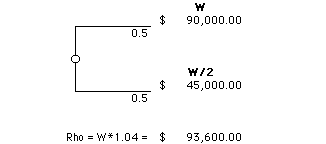Preferences

Values
How does the company decide whether one project is better than the other
in case when there is no uncertainty? Each company has their own
criteria - a specific metric they use to evaluate the success of a project.
For one company it could be the Return on Investment, for another company
it could be the total profit.
VOSI evaluates all its projects in terms of Net Present Value and will
choose a project with the highest NPV. Collapsing the cash flows
into one number (NPV) allows to compare different projects and cash flows.
To calculate NPV one has to estimate cash flows for every year over the
length of the project and then calculate the value of this cash stream
at the present time. In order to calculate this value we have to
know the company's time preference.
Time Preference
The present value of money depends on when that money is available.
For example, we can compare the value of getting $100 today vs. getting
$100 a year from now. If we have $100 now we can deposit it
in the bank and have $100+interest after a year. So, our time preference
depends on what we can do with that money. This is often expressed
in terms of discount rate (also called interest rate).
The discount rate used to calculate NPV represents decision maker's
time preference. Throughout this analysis we will use the discount
rate of 10%.
Risk Tolerance
Since every plan under consideration involves some uncertainty or risk,
it is necessary to consider exactly how much risk the company is willing
to take.
When considering deals with uncertain outcomes it is usually not enough
to consider the expected values of these deals. Consider the following
example:
You are offered two deals. If you choose Deal A, there is a 90%
chance that you will win $140 and 10% chance that you will lose $10.
If you choose Deal B, there is a 90% chance that you will win $1,250
and 10% chance that you will lose $10,000. Note that the two deals
have the same expected value. Which deal do you prefer?

If you choose your deals based on the expected value, then you should
be indifferent between the two. However, most of us would prefer
deal A because deal B is too risky. The choice of deals reflect our
risk preference.
Preferences are expressed by utilities, also called risk-adjusted
values, utility values, or u-values. One particularly convenient
form for expressing preferences is the exponential utility function:
u(x) = 1 - exp(-x/rho)
where rho is the risk tolerance.
Risk tolerance is a convenient measure for corporate risk attitude.
Several methods of assessing risk tolerance have been developed.
For example, we could offer a deal where the decision-maker has 50% chance
of winning $W and 50% chance of loosing $W/2. We can find such W
that the decision-maker will be indifferent between taking or not taking
the deal. Then the risk tolerance can be calculated as W*1.04.
For VOSI the risk tolerance is assessed as follows:

Another good approximation is setting risk tolerance to 6.4% of annual
sales.



![]()